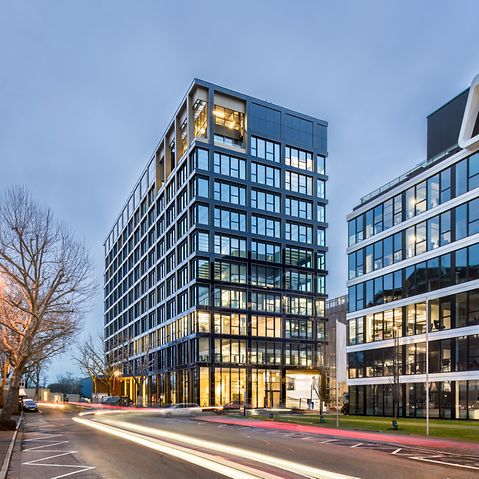
Meeting energy efficiency standards:
- BIPV allows the creation of ‘nearly zero-energy buildings’, as required by EU Energy Performance of Buildings Directive 2010/31/EU.
- The combination of highly thermally insulated building envelopes and BIPV by Schüco supports building investors in complying with requirements for sustainable and energy-efficient buildings.
CO₂ reduction and operational cost savings:
- A building with BIPV can generate energy itself, making a positive contribution to the carbon footprint.
- The energy generated by BIPV modules can be deducted from the calculated energy demand, leading to lower primary energy demand and reducing operating costs.
- Reduces dependency on primary energy market
- Improves energy certificate result with self-sufficient power
Evaluation by certification systems:
- BIPV is taken into consideration in various different building certification systems such as DGNB, LEED and BREEAM, which has a positive effect on the energy-efficient quality of the building.
- Taking CO₂ emissions and their integration into the energy certificate into consideration in terms of taxes can improve the cost-effectiveness of a building.
Versatile integration and design freedom:
- BIPV from Schüco offers a wide range of options for cells, colours and glazing, bringing with it maximum architectural freedom for building design.
- Individual designs can be created thanks to the flexible use of different cells in the modules to match the design requirements of the investor.
Recycling and sustainability:
- BIPV modules can be integrated into circular dismantling and recycling concepts.
- Research projects such as PVRe2 address the optimisation of recycling processes for BIPV modules to promote sustainability.
Broad range of uses:
- The versatile options for using BIPV modules – from façades to skylights to canopies and balconies – allow you to create customised solutions for many different building projects.
BIPV from Schüco offers building investors a comprehensive solution to cope with the increasing requirements for sustainable and energy-efficient buildings. The combination of highly thermally insulated building envelopes and BIPV allows “nearly zero-energy buildings” to be created in line with the EU Energy Performance of Buildings Directive. This not only contributes to the implementation of the climate-neutral building targets set by the German government for 2050, but also offers economic benefits.
One major plus with BIPV is the reduction of CO₂ and its associated operational cost savings. Buildings that are turned into energy suppliers with BIPV can deduct the generated energy from the calculated demand, leading to lower primary energy demand. This makes a positive contribution to the operational carbon footprint and supports compliance with the German Energy Saving Ordinance.
The versatile integration of BIPV allows architects and investors to realise their design visions. With a wide range of options for cells, colours and glazing, Schüco offers maximum architectural freedom. The flexible configuration of the modules allows individual designs to be created and the BIPV modules receive positive evaluations from various building certification systems such as DGNB, LEED and BREEAM.
Another major benefit is the sustainability and recyclability of BIPV modules. Schüco is actively committed to research projects such as PVRe2, in order to optimise recycling processes. The integration of circular dismantling and recycling concepts makes BIPV a long-term environmentally-friendly solution.